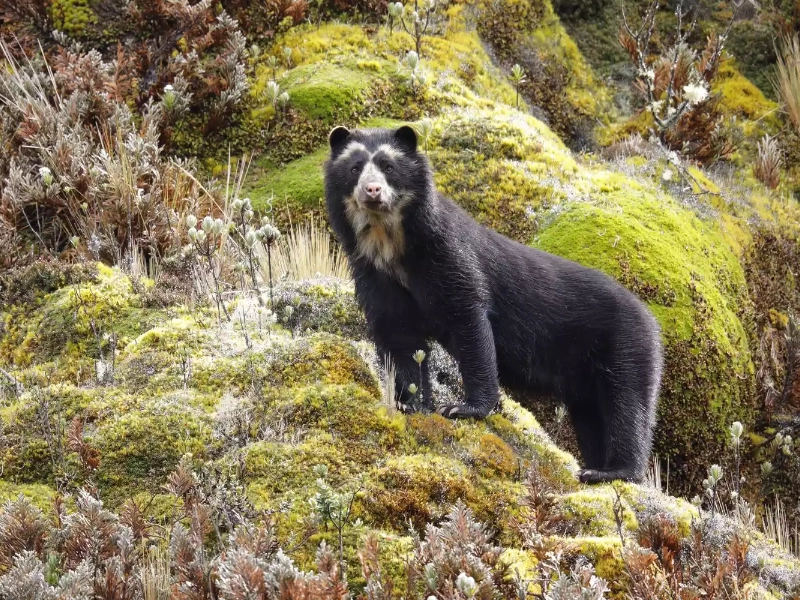8 Completely Unique Types of Bears
8. The Spectacled Bear: South America's Unique Ursine

The only bear species native to South America, the Spectacled Bear (Tremarctos ornatus), sometimes referred to as the Andean Bear, is Found in the Andes Mountains and neighbouring mountain ranges, this medium-sized bear lives in a wide spectrum of environments from alpine meadows to cloud forests. Representing a unique evolutionary lineage and a vital part in its environment, the spectacled bear is the last living short-faced bear and the lone survivor of the Tremarctinae subfamily.
The spectacled bear gets its name from the characteristic cream-coloured or yellowish rings around its eyes, which frequently span the muzzle and down the nose to produce a spectacle-like effect. But these marks can vary greatly between people; some bears have really noticeable "spectacles" while others have either hardly apparent or even nonexistent marks. Usually black or dark brown, its coat offers great hiding in their woodland environment.
Comparatively to other bear species, spectacled bears have a modest size. Men normally weigh between 220 to 440 pounds (100 to 200 kg), whereas women are lighter and weigh 77 to 181 pounds (35 to 82 kg). Their strong limbs and keen claws—adaptations that help them to be great climbers—cause a stony build. Foraging as well as escape from any dangers depend on their capacity to climb trees.
Spectacled bears' eating is among the most amazing feature of them. Spectacled bears are virtually totally herbivorous unlike many other bear species who are either mostly carnivorous or have a mixed diet. Their main foods include fruits, berries, cactus, and bromeliads. In many places, the fruits and leaf bases of several kinds of plants in the bromeliad family represent a major component of their diet and they have particular affection for them. Strong jaws and sturdy molars for processing hardy plant material are among the numerous adaptations resulting from this specialised diet.
Though they are herbivores, spectacled bears will sometimes eat meat—small mammals, birds, insects, and so on. In some places, they have even been known to target bigger animals like deer or cattle; but this is somewhat rare and usually results in confrontation with nearby farmers.
The habitat of the spectacled bear spans dry woods and páramo grasslands of the high Andes to the humid cloud forests of the eastern Andes slopes. The wide spectrum of ecosystems has resulted in notable differences in behaviour and diet amongst populations. While in some regions spectacled bears remain in high-altitude páramo environments year-round, in others they may drop to lower elevations to eat ripe fruits.
Spectacled bears exhibit among their most amazing habits building eating platforms in trees. These bears may bend and break branches to provide strong platforms where they may comfortably perch and eat food that would otherwise be out of reach. An crucial component of the forest ecosystem, these platforms can be rather big and are regularly used by the same bear or other bears in next years.
The difficulties of researching these secretive animals in their far-off habitats make the reproductive cycle of spectacled bears not well known. Still, it is well known that women usually bear one or two cubs every two to three years. Born blind and defenceless, cubs weigh only around a pound (450 grammes). For up to a year, they stay with their mother learning basic survival skills and foraging techniques.
Sadly, spectacled bears suffer several dangers in the wild, just as many other big mammal species. For most of their area, habitat loss and fragmentation brought on by infrastructural development, agricultural expansion, and deforestation top issues. Human-bear confrontations have becoming rather common as human populations spread into bear habitat. Farmers may respond with retaliatory kills when spectacled bears attack cattle or crops.
Also seriously threatening spectacled bear populations is poaching. Their body parts, which are used in traditional medicine, and the illicit pet trade drive much of their targeting. The problem has been exacerbated by the ease with which poachers may reach bear habitats thanks to the development of road networks into once isolated locations.
For spectacled bears, climate change adds still another difficulty. The cloud forests and páramo ecosystems the bears depend on are moving upslope as temperatures rise. This could result in a major loss of appropriate habitat, therefore fragmenting populations and perhaps complicating bear movement between several sites.
Efforts at conservation for spectacled bears centre on habitat protection, so lowering human-bear conflict, and so preventing poaching and illicit trafficking. Maintaining spectacled bear populations and their habitats depends much on protected areas such national parks and wildlife sanctuaries. Furthermore, community-based conservation projects seek to inform nearby people on the value of spectacled bears and advance cohabitation between people and bears.
Constant research on spectacled bear ecology, behaviour, and population dynamics yields important new information that guides conservation plans. These research not only support the preservation of the species but also advance knowledge of Andean ecosystems and the intricate interactions among the several species in these habitats.
Ultimately, the spectacled bear is a singular and interesting member of the bear family. Conservation of this last living short-faced bear, the only bear unique to South America, is very crucial not only for the species but also for the preservation of a whole evolutionary line. Keystone species in Andean ecosystems are the spectacled bear since its influence on forest structure by means of eating platforms and seed distribution. Maintaining the Andes Mountains' biodiversity and ecological balance depends on preserving these bears and their habitats, among the most biodiverse and vulnerable areas on Earth. It is abundantly evident as our knowledge of these amazing species grows that the destiny of the spectacled bear is intrinsically related to the health and future of mountain ecosystems in South America.
Advertisement
You May Like

